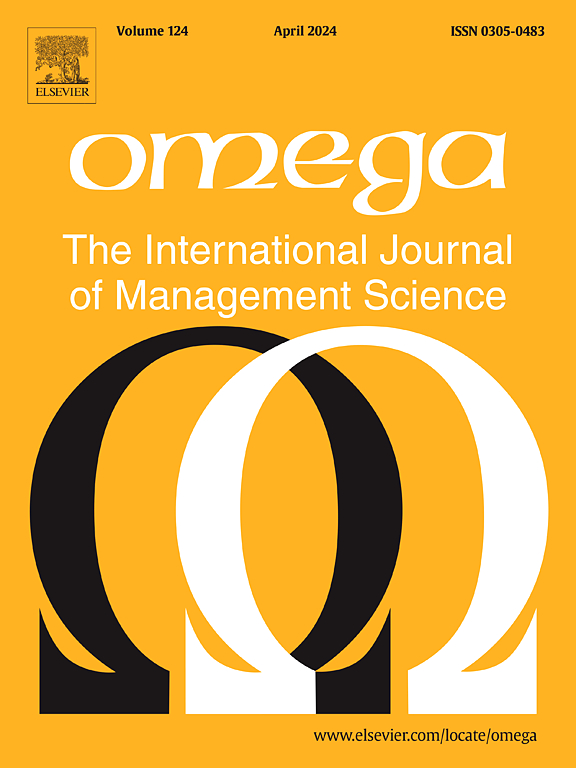需求不确定的设备租赁供应链
IF 7.2
2区 管理学
Q1 MANAGEMENT
Omega-international Journal of Management Science
Pub Date : 2025-05-08
DOI:10.1016/j.omega.2025.103358
引用次数: 0
摘要
设备租赁在许多行业都是一项大业务,而且发展迅速。在与行业互动的激励下,我们考虑了一个设备租赁供应链,其中制造商将设备租赁给运营商,运营商使用该设备以随机需求率为其客户提供服务。制造商和运营商签订一份基于使用情况的租赁合同,根据该合同,运营商向制造商支付固定租金和每单位设备使用的可变租金,而制造商在租赁期间提供维护服务。在这个供应链中需要做出两个决策:制造商的定期预防性维护政策和运营商的生产率(或设备使用率)决策。首先提出了Stackelberg博弈模型,即制造商作为领导者,在实际需求已知之前首先确定维修策略,以使自身的预期利润最大化;运营商作为追随者,在制造商的维修策略已知之后,确定实际需求已知后的最优生产率,以使自身的利润最大化。我们还提出了一个集中式模型,在实际需求已知后,双方共同做出维修和生产率决策,以最大化供应链的总利润。我们对这些模型进行分析和求解,并在需求不确定性存在的情况下,对制造商的维护政策和运营商的生产率之间的相互作用获得各种见解。计算结果表明,在Stackelberg均衡下,供应链的总期望利润始终低于最优集中解决方案下的期望利润。为了提高Stackelberg博弈下供应链双方的预期利润,我们提出了两种协调机制:不进行信息共享的成本分担激励机制和成本信息共同共享机制。研究发现,当设计合理时,成本分担机制可以提高制造商和运营商的期望利润。但无法消除需求信息不对称带来的负面影响,无法实现最优集中解决方案。另一方面,共同成本和信息共享机制产生的解决方案既提高了双方的预期利润,又对集中式系统最优。本文章由计算机程序翻译,如有差异,请以英文原文为准。
Equipment leasing supply chain with demand uncertainty
Equipment leasing in many industries is a big business and growing fast. Motivated by our interactions with industry, we consider an equipment leasing supply chain where a manufacturer rents a piece of equipment to an operator who uses the equipment to serve its customers with a stochastic demand rate. The manufacturer and the operator sign a usage-based lease contract under which the operator pays a fixed rental plus a variable rental per unit of equipment usage to the manufacturer, while the manufacturer provides maintenance services during the lease period. There are two decisions to be made in this supply chain: the manufacturer’s periodic preventive maintenance policy, and the operator’s production rate (or equipment usage) decision. We first propose a Stackelberg game model, where the manufacturer acts as the leader and determines the maintenance policy first before the actual demand is known to maximize its own expected profit, followed by the operator who acts as the follower and decides the optimal production rate after the actual demand becomes known to maximizes its own profit, given the manufacturer’s maintenance policy. We also propose a centralized model, where the two parties jointly make the maintenance and production rate decisions after the actual demand is known, to maximize the total profit of the supply chain. We analyze and solve these models analytically and obtain various insights into the interplay between the manufacturer’s maintenance policy and the operator’s production rate in the presence of demand uncertainty. Our computational results show that the total expected profit of the supply chain at the Stackelberg equilibrium is consistently lower than that at the optimal centralized solution. To improve the expected profit for both parties in the supply chain under the Stackelberg game, we propose two coordination mechanisms: a cost-sharing incentive mechanism without information sharing, and a joint cost and information sharing mechanism. We find that when designed properly, the cost sharing mechanism can improve the expected profit for both the manufacturer and the operator. However, it cannot eliminate the negative effect brought by the asymmetric demand information, thus failing to achieve the optimal centralized solution. On the other hand, the joint cost and information sharing mechanism yields a solution that improves the expected profit for the both parties, and is also optimal for the centralized system.
求助全文
通过发布文献求助,成功后即可免费获取论文全文。
去求助
来源期刊

Omega-international Journal of Management Science
管理科学-运筹学与管理科学
CiteScore
13.80
自引率
11.60%
发文量
130
审稿时长
56 days
期刊介绍:
Omega reports on developments in management, including the latest research results and applications. Original contributions and review articles describe the state of the art in specific fields or functions of management, while there are shorter critical assessments of particular management techniques. Other features of the journal are the "Memoranda" section for short communications and "Feedback", a correspondence column. Omega is both stimulating reading and an important source for practising managers, specialists in management services, operational research workers and management scientists, management consultants, academics, students and research personnel throughout the world. The material published is of high quality and relevance, written in a manner which makes it accessible to all of this wide-ranging readership. Preference will be given to papers with implications to the practice of management. Submissions of purely theoretical papers are discouraged. The review of material for publication in the journal reflects this aim.
 求助内容:
求助内容: 应助结果提醒方式:
应助结果提醒方式:


